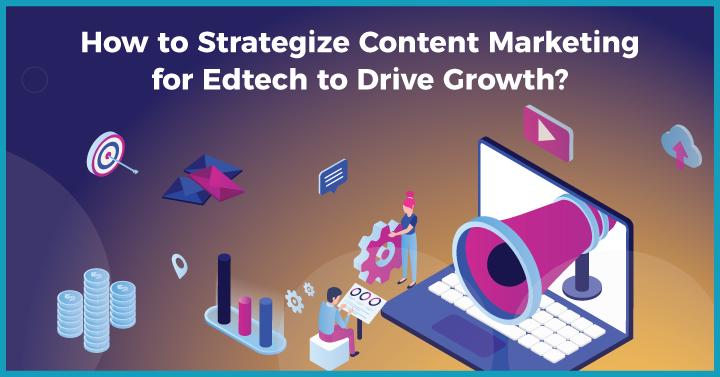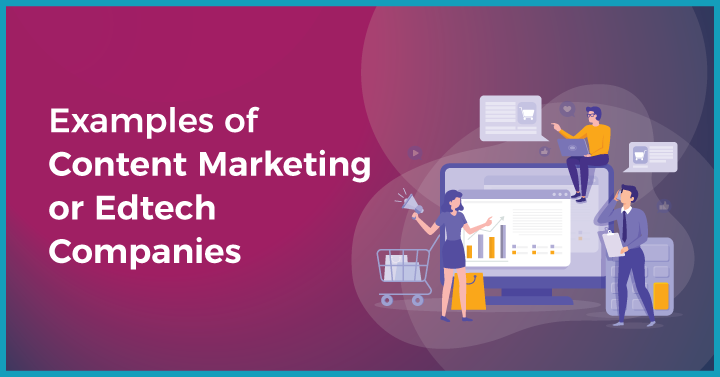According to Align.me, 74% of B2B firms utilise content marketing for brand awareness and lead generation.
The above statistics clearly showcase the impact of content marketing in the B2B realm and Edtech is no exception. Edtech businesses are harnessing the power of content marketing to develop brand presence, boost engagement, and drive sales. By crafting informative and compelling content copies that are tailored to customers’ needs, Edtech companies can gain traction of relevant audience in a competitive marketplace.
However, generating leads and achieving your goals through content marketing goes beyond merely churning out content. It involves understanding the target audience, narrowing down the right KPIs, identifying the right keywords, strategic distribution of content across the right channels, and much more.
2. What Is Edtech Content Marketing? Why do you need it?
Edtech content marketing is the strategic use of content, such as blog posts, articles, webinars, and other forms of educational material, to promote and grow educational technology (Edtech) businesses. The primary objective of Edtech content marketing is to attract, engage, and convert the target audience, which often includes educators, students, administrators, and other stakeholders in the education sector.
Content marketing for EdTech can impact multiple areas of the brand, such as – web traffic, backlinks, social media activities, leads, and conversions. Following are some benefits of EdTech content marketing –
- Increase in website traffic : According to Aberdeen, websites with blog posts have seen 7.8x times higher year-on-year growth in unique visitors. The reason behind this is companies with a blog have more indexed pages than those without a blog. Hence, more content leads to more traffic.
- Higher ROI: Content marketing captures 3x more leads than paid advertising. Also, it costs 62% less compared to other marketing tactics.
- Show authority and expertise: A credible library of content shows your domain authority and draws the attention of decision-makers. According to Edelman-LinkedIn research, 60% of decision-makers said that authority and thought leadership convinced them to choose a service they had never heard of previously.
3. How to Strategise Content Marketing for Edtech to Drive Growth?

Content marketing for EdTech is not just randomly publishing a large volume of content – blogs, social media posts, landing pages, emails, videos, etc. Lots of brands go wrong with content because they lack “strategy.”
For example, EdTech firms might create a video that looks more like a promotional (high-quality and professional) video than explainer content. However, the content will not help unless it resonates with the target group at a specific journey stage.
You can build relationships with intended markets using the right content marketing strategy. If you are creating a content marketing strategy for your EdTech or revisiting it, follow these tactics –
3.1 Know Your Target Audience
Did you know? Nearly, $37 billion in advertising expenditure is wasted every year by not targeting the right audience.
Finding your target audience is the key to creating great content. But, do you know who your target audience is? Here are some questions that help you in knowing whom you should target and where –
- What are the types of your audiences?
- What is the role of your target audience?
- Which channels are they likely to use?
- What are their interests?
Understanding the audience’s behaviour will help you produce valuable and action-driven content. EdTech companies often sell to a broader range of audiences, including public/private schools, specialised institutions, universities, and even educational enterprises. It is crucial to understand how the marketing funnel works for each of these audiences separately. Segment the target audience by narrowing down the list to something smaller like – K-2, K-12, or higher education – rather than targeting all “teachers” or “students.”
Next, consider secondary audiences and entities that influence the target audience. For instance, students are influenced by parents; school administrators influence teachers, etc. The next step is to build personas like – demographics, motives, barriers, connections, profiles, etc., to which the EdTech tailors its products. A finely tuned persona will help the EdTech directly address and solve the customer’s problems.
3.2 Establish the KPIs
KPIs like blog views, social shares, engagement, inbound links, followers, CTR, cost per lead, etc. will help you understand if you are using the right channels and if your audience finds your content valuable. In addition, a data-driven sales funnel will help you operate rationally while translating to more sales.
EdTech firms often make the mistake of creating content ‘just for creating it”. Instead, firms should align the content with the goals or objectives. For example, some of the goals EdTech brands might want to focus on are – increasing brand awareness, generating sales leads, converting more leads into customers, and improving customer retention.
Based on these goals, establish the KPIs. For example, if your goal is to generate sales leads, the KPIs should include – landing page conversion rates, the number of leads generated by each piece of content, etc. Now, take some time and figure out the goals and KPIs at a high level, and then create an edtech content strategy to help you get there.
3.3 Audit & Optimise Existing Content
Is some of your existing content no longer relevant? When it comes to achieving EdTech content marketing goals, the first thing that comes to mind is consistently creating and distributing new content. However, if existing content gets buried and is rarely reused, it can be a problem. Updating existing content can be one of the most efficient marketing tactics that can benefit EdTech firms.
To start with –
- Take an inventory of existing content such as blog posts, educational materials, case studies, landing pages, or external publications.
- Use online tools like SEMRush Content Audit to analyse the content. Conduct keyword analysis to check if the content needs new keywords.
- Ensure the new keywords are being incorporated into the content, meta title, and meta description for targeted SEO strategy.
- Make sure the content is informative and provides valuable information, insights or solutions related to educational challenges and opportunities.
It is also important to note here that if the content is performing well, you can use it for repurposing, which is also considered as one of the content marketing best practices.
3.4 Create Action-Driven Landing Pages
EdTech landing pages are created for paid media or marketing campaigns and are typically aimed at increasing conversions. When the visitor clicks on the CTA, it should be redirected to a targeted landing page that describes exactly what your services are about and how they will benefit them. Check out the examples of EdTech landing pages. Here are a few things to consider when creating EdTech landing pages –
- A headline that clearly explains what the page is about, such as – education, discipline, degrees, etc., that makes you the best educator.
- The image that is relevant to the offer or program. For example – a picture of a student, college campus, classroom, etc.
- Highlights of the program or offers that help the visitor understand why they should choose the EdTech
- Accreditation badges or testimonials with images that show your achievements
- Navigation links and CTA that makes the EdTech landing page a chore to read
- Easy to fill out registration form
- Contact details like – telephone, email, address, etc.
To analyse if the EdTech landing page has all it takes to get students interested in your program, run A/B testing. Some more EdTech website templates –
- Educare – Education WordPress Theme for University, School, and Academics
- Bible – Education WordPress theme
- Educlam – Educational landing page
Use dedicated landing pages to boost student registration for a course, workshop, or program.
3.5 Choose the Best Content Distribution Channel
According to recent stats, 95% of adults aged between 18-34 closely follow brands on social media.
With an abundance of platforms available, it can be overwhelming to decide where to distribute your content. Merely publishing an educational or informative blog on a website isn’t always enough.
Edtech brands need a diversified content marketing plan for broader reach and maximum impact. Some of the best content distribution channels for edtech include – YouTube, Facebook, Instagram, Tumblr, Podcast, and Mobile Apps.
Before deciding which platform to choose, you need to understand your goals. Some of the factors to consider are –
- Will the platform help me achieve goals?
- Which channels are my competitors using?
- Will the form of content suitable for this platform?
These questions help you choose the right content distribution channel for wider reach and better engagement. Besides social media channels, interactions in communities, forums, and niche groups are another option. As a part of regular community interactions, you can publish EdTech content on various forums.
Some educational institutions even use community-building platforms such as Edmodo, Wikispaces, etc., to help teachers, students, and educators to communicate and share their work. For example, EdTechHub is a platform for EdTech that closely connects teachers, parents, and ministry staff. They also provide learning materials to help parents get involved in students’ learning.
3.6 Prepare a Content Plan/Calendar
If you want your EdTech business to stand out from your competitors, you need a well-structured content plan. Whether you want to drive more traffic or increase engagement on social media channels – consistent posting is the key to success in content marketing for Edtech.
The challenge? It’s hard to develop educational content on a weekly or daily basis. Mainly, when it comes to social media – the most challenging part is to keep the content engaging and relevant. A well-designed and well-maintained content calendar help plan the posts ahead of publishing. You can create content in batches and post them according to the schedule.
A good number of content calendar templates make information available at a glance. You can choose a suitable template from Hootsuite, ContentCal, CoSchedule, HubSpot, etc., to continuously create captivating content. These templates also help you to identify the best time to post content. For instance, Mondays and Fridays are the best days to publish a blog.
Here are some examples of editorial or content calendars –
- https://www.edtechdigest.com/edcal-2019/
- https://edtechmagazine.com/k12/editorial-calendar-3
- https://edtechmagazine.com/higher/editorial-calendar-2
To ensure your content is not lost in the target audience’s feed, prepare a content calendar that helps prioritize your posts.
3.7 Publish Keyword-Rich Content
Keyword-rich content is vital when it comes to content marketing for EdTech. To optimise your website for search engines, you can use long-tail keywords since they are used exclusively.
For instance, rather than using the keyword – “schools in the USA,” you could use a more distinct phrase, like – “what are the best schools in the USA?” The latter phrase is likely to drive more organic traffic to your website.
Some popular suggestions for education keywords on Wordstream are –
| Keywords | Search Volume |
| School | 1830000 |
| University | 673000 |
| Department of Education | 301000 |
| Education Portal | 246000 |
| Ministry of education | 135000 |
| School Education | 11000 |
Make sure to optimize images on your website, as photos get 94% more organic traffic than text content. Use appropriate alt images, alt text captions, and keywords to explain the picture. Also, use local keywords for your edtech to show up on local search results. For example, use keywords like – best schools near me, top colleges near me, etc.
Check how your keywords perform using online tools like – SEMrush, Ahrefs, Moz, etc.
3.8 Educate using multiple Content Formats
According to sources, valuable content generates 3x times as many leads as outbound marketing.
Inbound marketing is the best way to reach potential customers, whether you are into online education or selling a training product. Several forms of content, such as blogs, videos, infographics, white papers, and ebooks, form a cohesive part of the inbound marketing strategy. A successful content marketing strategy revolves around informative content that attracts a new audience and engages the existing audience.
3.9 Repurpose Your Existing Content
Does your website have an FAQ section? Have you got a blog post that is driving more traffic? Tweak your existing content to make it appropriate for each specific channel to boost reach and generate more leads. You can turn it into an infographic, PPC, slideshow, GIF, video, etc., and share it on multiple platforms.
By repurposing your EdTech content, you are increasing your online visibility, which is very important for brand awareness. Some of the key benefits are –
- Improves SEO and organic search efforts
- Enhances brand visibility and recognition
- It helps gain more followers on social media
- Keeps the target audience engaged
When creating a new content or blog post, produce it with ‘repurposing’ in mind. For example, if a post gets more engagement on Facebook, you can also turn it into a YouTube video. You can also consider creating an eBook if you have multiple posts on the same subject.
3.10 Utilise automation to scale the campaigns
According to sources, more than 76% of firms have raised their ROI within a year of implementing automation.
Marketing automation is the latest digital trend that allows EdTech brands to take more time for other tasks by automating specific components of outreach. Moreover, as the above study suggests automation also helps in improving marketing ROI. One aspect that EdTech marketers can think of automating is landing pages.
For instance, suppose a visitor takes a particular action on the website, such as filling out the registration form or downloading an ebook, there should be an automated response that pushes the visitor into the funnel. Automating the landing pages will save time and effort to improve the visitor’s journey.
Now that we understand the steps to strategise content marketing, let’s have a look at the latest content marketing advancements-
4. Content Marketing Trends to Embrace in 2023
Here are some of the content marketing trends that can help brands achieve their goals –
4.1 Stand Out from Competitors with Visual Content
Visual forms of marketing have been gaining momentum in recent years, especially in the education sector. Visual content can substantially increase engagement among students, teachers, parents, and other audiences. It is estimated that visual content like infographics and PPTs are shared 3X more on social media than text content.
Practically, an e-learning app launches a multimedia brand awareness campaign that garnered 30+ million views within a short span. The visual elements of the campaign that complemented the jingle-style messaging created an engaging user experience.
4.2 Optimise Content for Voice Search
According to statistics, nearly 1 billion voice searches are done per month.
Voice search is a significant content marketing trend dominating the search landscape. Optimising content for voice search aims at making it more compatible with voice-activated digital assistants and devices such as Google Assistant, Amazon’s Alexa and Apple’s Siri.
Content optimisation for voice search involves tailoring your content to match natural language queries and using long-tail keywords that mimic the way people speak and ask questions. Moreover, structuring your content to provide information in question-and-answer format further increases the likelihood of being featured in voice search results.
4.3 Invest in Video Content Marketing
According to Biteable, 65% of marketers say that videos are more helpful than Google Ads. Speaking of the target audience, you’re probably wondering who’s going to watch your videos? Well, YouTube reaches more people aged between 18-49 than all the TV channels combined.
Edtech brands can leverage the power of video content by opting to share their knowledge and expertise through short videos – rather than large chunks of text. For instance, EdTech firms can use online tools and visual aids instead of theoretical (text-based) content to teach how to solve a mathematical equation.
Reputed EdTech brands like Unacademy, Udemy, and Coursera use video content to engage students. As the young generation watches and learns a lot from videos, they capture the attention of a large audience. Here are some roundups of extraordinary video marketing –
- List of eCommerce product videos by BigCommerce
- Engaging videos on social media by Sprout Social
- Marketing videos by Hearst Media
With video marketing, you will see endless possibilities to engage your audience.
4.4 Capture the Audience With Audio Content
When it comes to content marketing for EdTech, most firms have these questions in mind –
- How to build a personal brand?
- How to help audiences take the next step?
- Where does my audience hang out online?
Well, podcasts are the best way to attract the young generation, especially millennials. According to Search Engine Journal, about 54% of podcast listeners are more likely to follow a brand after they hear a podcast of that brand.
With the rapid expansion of educational technology, EdTech firms can bring new ideas and advice to their audience through podcasts. They allow brands to captivate their audience with engaging audio content.
The EdTechPodcast is the best example of an EdTech podcast that aims to improve the dialogue between ‘ed’ and ‘tech .’ Connect with your target audience and retain them for the long term using podcasts. Some of the best EdTech podcasts are as below –
- Coffee with a Geek by a former elementary school teacher discusses with educators about their powerful learning experiences.
- Easy EdTech Podcast author of Class Tech Tips provides insights into education from her years of experience. Also, she shares her reviews on EdTech products in these podcasts.
- EduTech Guys hosted by Jeff Madlock and David Henderson, engage educators on various topics in education.
EdTech companies can use podcasts to engage current and potential customers more.
4.5 Go Live With Webinars
Webinars can be a perfect tactic for EdTech companies. These are web-based multimedia lessons, discussions, seminars, and demonstrations that can reach a broader audience. Educational institutions do not have to make considerable investments in webinar marketing. Check out some examples of webinars in the EdTech sector are –
- https://edtech.worlded.org/events/
- https://edtechreview.in/resources/webinars-courses
- https://www.edsurge.com/e/webinars
With web-based webinar software like – MegaMeeting, WebinarNinja, Webinar Jam, etc. – educational institutes can record live meetings and share them for further use. Students, parents, teachers, and other participants and non-participants can access the webinars anytime.
5. Examples of Content Marketing for EdTech Companies

Content marketing matters greatly for EdTech companies because it helps them build trust and share their experience. People who buy educational products or services need to know more about the company and its expertise. We’ve got some examples, which are more meaningful in today’s competitive landscape.
KiwiCo is an EdTech brand that creates subscription boxes for kids to learn STEM, STEAM, ad Science skills. As a part of their EdTech content strategy, they create DIY content with ideas for crafts, activities, and experiments for children.
Parents can search the DIY content by category or age. They built trust and engagement with step-by-step instructions, supplies lists, and instructional videos. The best thing is that the DIY tutorials include links to the KiWiCo products that can be purchased with a single click.
Coursera is an e-learning platform where anyone can enroll to learn topics that range from coding to accounting to digital marketing. As a part of their EdTech content strategy, they maintained a Tumblr blog where they put more personal information about the brand. For instance, one of their blogs mentioned how one of their students used Coursera to build their career.
Also, the EdTech brand included several success stories on its blog. For instance, it had a success story of a Tanzanian farmer who used material from Coursera to bring sustainable farming to his village.
- Conclusion
Whether for school, college, university, or any other educational institute, knowing how to reach the decision-makers and nurturing them can help drive profitable results.
Growth Ganik works on the best content marketing strategies that help grow your EdTech business. With decades of intensive industry experience, we provide EdTech brands with scalable and customized content marketing plans that meet your business goals.
Get in touch with us to know how Growth Ganik provides EdTech firms with an action-driven content marketing strategy.
6. How can a Digital Marketing Agency Help?
A digital marketing agency can help you craft an effective content marketing strategy that drives website traffic, educates your audience, builds authority and converts more leads. They can even help you market the content on the right channels to generate more traction and boost reach.
Growth Ganik is a rapidly evolving digital marketing agency in Sydney, Australia that offers a full suite of digital marketing services, including SEO, content marketing, and growth marketing. Our scientific and data-led approach ensures that you achieve desired goals and generate higher ROI through content marketing efforts.
Book a free consultation with our content strategists today to elevate your strategy.
7. FAQs
- What is content marketing, and how does it apply to the edtech industry?
Content marketing involves creating and distributing valuable, informative, and relevant content to attract and engage a specific audience. In the edtech industry, content marketing can be used to provide educational resources, insights, and solutions to address the needs of students, teachers, and educational institutions.
- How can content marketing help edtech businesses in lead generation?
Content marketing plays a vital role in lead generation for edtech businesses by offering valuable content that addresses the unique challenges of Edtech sector, gradually building trust and encouraging students to opt for the courses and certifications.
- How to create compelling content that resonates with the target audience in the edtech sector?
To create content that resonates with the Edtech audience, start by gaining a deep understanding of the audience’s needs and pain points. Research your target demographic, develop buyer personas, and tailor your content to address their specific challenges. Consistently produce high-quality content that not only informs but also engages the edtech audience.

















